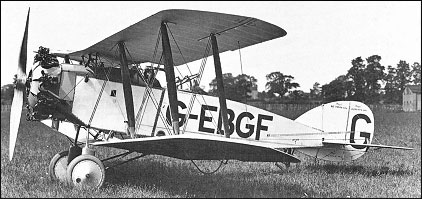- Bristol Jupiter Fighter
infobox Aircraft
name = Jupiter Fighter
type = Fighter/Trainer
manufacturer =Bristol Aeroplane Company 
caption =
designer =
first flight = June 1923
introduced = 1924
introduction=
retired = 1934
status =
primary user =
more users =
produced =
number built = 26
unit cost =
developed from =Bristol F.2 Fighter
variants with their own articles = The Bristol Type 76 Jupiter Fighter and Type 89 Trainer were derivatives of the Britishfighter aircraft ofWorld War I (theBristol F.2 Fighter ), powered byBristol Jupiter radial engine s. While unsuccessful as a fighter, it was used as an advanced trainer aircraft between 1924 and 1933.Design and development
In order to demonstrate their new Jupiter engine in an inexpensive yet relatively high performance aircraft,
Bristol Aeroplane Company authorised the conversion of three war surplusBristol F.2 Fighter airframes to use the Jupiter, to create the Type 76 Jupiter Fighter, which it was also hoped to sell as a fighter to foreign air forces Mason, Francis K. "The British Fighter since 1912". Annapolis, Maryland: Naval Institute Press, 1992. ISBN 1-55750-082-7.] .The first of these three aircraft flew in June 1923. While the engine installation proved satisfactory, as the Type 76 had the same fuel capacity as the Bristol Fighter, the increased fuel consumption of the Jupiter compared with the Bristol Fighter's original
Rolls-Royce Falcon meant that the aircraft had inadequate range for use as a fighter, while the slipsteam over the observer's cockpit meant that the observer could not use hisLewis Gun . Because of these flaws, no more type 76s were built after the initial three.While unsuitable as a fighter, the success of the engine installation of the Jupiter Fighter resulted in the decision to produce an advanced trainer version, to supplement the
Siddeley Puma -enginedBristol Tourer s already in use in this role. The result of this combination was the Type 89 Trainer, a total of 23 of which were producedBarnes, C.H. "Bristol Aircraft Since 1910". London: Putnam, First edition, 1964.] .Operational history
While the first Jupiter Fighter was evaluated at
Martlesham Heath and found wanting, being lost 23 November 1923 when the engine seized at high altitude [Green, William, and Swanborough, Gordon, "Fighter A To Z", "Air International ", Bromley, Kent, U.K., January 1975, Volume 8, Number 1, page 46.] , the second was sent toSweden for evaluation, where it coped excellently with the extreme cold of the Swedish winter, with the Jupiter, using normal fuels and winter motor oil, operating without trouble in temperatures which normally caused engine oil to freeze in hours. The second Type 76 was therefore purchased by theSwedish Air Force , who operated it from May 1924 until 1935, when it was sold to a private buyer, finally being written off in 1936. The final Type 76 was used as a testbed for a high compression version of the Jupiter intended for use at high altitudes, which was fitted with a bi-fuel system to allow use of alcohol at low altitudes, then switching to normal petrol once the aircraft had reached sufficient altitude to prevent premature detonation "(Engine knocking )". This system was rejected in favour ofsupercharging .The Jupiter-powered advanced trainers entered service with the Bristol-operated Reserve Flying School at
Filton in 1924 . They were also used by the Reserve Flying School atRenfrew operated byWilliam Beardmore and Company , with the Beardmore-owned aircraft being powered by Jupiter VI engines, while the Filton-based aircraft were powered by surplus Jupiter IV engines, as an economy measure. They remained in use at Renfrew until 1930, and at Filton until 1933, when they were replaced byHawker Hart trainers and scrapped Jackson, A.J. "British Civil Aircraft since 1919 Volume 1". London: Putnam, 1974. ISBN 0-370-10006-9.] .Variants
;Type 76:Prototype Bristol Jupiter Fighter. One built.
;Type 76B:Second prototype Jupiter Fighter - sold to Sweden, otherwise known as Swedish Fighter
;Type 76A:Third Jupiter Fighter - used for testing experimental bi-fuel Jupiter. Later converted to Type 89
;Type 89:Jupiter powered advanced trainer. Nine built.
;Type 89A:Modified trainer with new,
plywood coveredmonocoque fuselage. 15 built (including one built at Renfrew from spare parts and salvaged components from crashed aircraft)Operators
*
Swedish Air Force *Filton Reserve Flying School
*Renfrew Reserve Flying School
pecifications (Type 89)
aircraft specification
plane or copter?=plane
jet or prop?=prop
ref=British Civil Aircraft since 1919 Volume 1
crew=2
length main= 25 ft 0 in
length alt= 7.62 m
span main= 39 ft 3 in
span alt= 11.97 m
height main= 9 ft 0 in
height alt= 2.74 m
area main= 405 ft²
area alt= 37.6 m²
empty weight main= 2,326 lb
empty weight alt= 1,057 kg
loaded weight main= 3,250 lb
loaded weight alt= 1,477 kg
engine (prop)=Bristol Jupiter IV (derated)
type of prop= 9-cylinder single rowradial engine
number of props=1
power main= 320 hp
power alt= 239 kW
max speed main= 96 knots
max speed alt= 110mph, 177 km/h
cruise speed main= 82 knots
cruise speed alt= 94 mph, 151 km/h
range main= 296 nm
range alt= 340 mi, 580 km
ceiling main= 22,150 ft [Ceiling for Jupiter Fighter]
ceiling alt= 6,750 m
loading main=8.02 lb/ft²
loading alt=39.3 kg/m²
power/mass main=0.098 hp/lb
power/mass alt=0.16 kW/kg
armament=References
External links
* [http://www.britishaircraft.co.uk/aircraftpage.php?ID=157 British Aircraft Directory]
Wikimedia Foundation. 2010.
